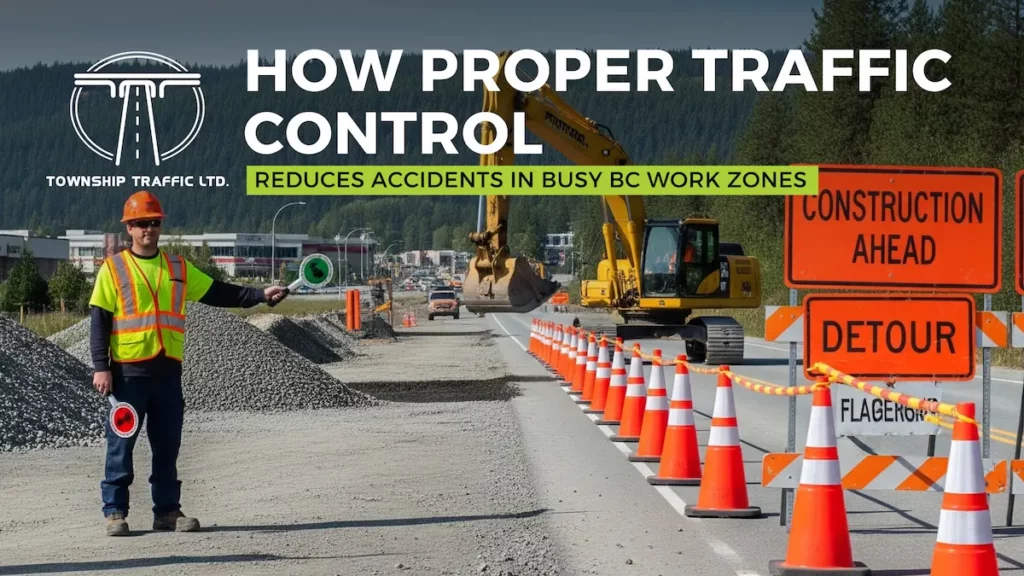Work zones in British Columbia are essential for maintaining safe, functional, and efficient roadways. Whether it’s road construction in Vancouver, utility repairs in Surrey, or highway maintenance across the Fraser Valley, these projects are critical for keeping our transportation network in top shape. However, they often take place in high-traffic areas, where both construction workers and motorists face increased risks.
Without proper traffic control measures, busy BC work zones can quickly turn into dangerous accident zones, putting lives, property, and project timelines at risk. Factors like driver confusion, speeding near construction sites, and limited visibility can make these areas hazardous for everyone on the road.
That’s why professional traffic management services, such as those provided by Township Traffic are vital. With strategic traffic control plans tailored to local road conditions, these experts help prevent collisions, protect workers, guide drivers safely through work areas, and keep traffic flowing smoothly. By combining trained flaggers, clear signage, and compliance with WorkSafeBC traffic safety regulations, they ensure that BC’s work zones are not only productive but also safe for all road users.
Why Traffic Control Is Critical in BC Work Zones
British Columbia’s extensive road network serves thousands of daily users, including commuters, commercial trucks, cyclists, and pedestrians. When a work zone disrupts traffic flow—whether on busy highways in Vancouver, arterial roads in Surrey, or local streets in Abbotsford—it increases the likelihood of driver confusion, sudden lane changes, and speeding. These factors create a higher risk for accidents, endangering both workers and motorists alike.
Effective traffic control in BC work zones is essential for preventing these dangers. First, it protects construction workers by establishing clear and safe buffer zones that keep them physically separated from moving vehicles. Secondly, it guides drivers safely through work areas with strategically placed, easy-to-understand signage, trained flaggers, and marked lanes, helping to reduce uncertainty and hesitation.
Moreover, proper traffic control helps prevent traffic congestion around construction zones, which is a common trigger for aggressive or distracted driving behaviours that lead to collisions. Finally, using professional traffic control services ensures full compliance with WorkSafeBC and British Columbia Ministry of Transportation regulations, meeting all legal safety standards to protect workers, drivers, and project managers.
By prioritizing these measures, BC work zones remain safer and more efficient for everyone on the road.
Common Causes of Work Zone Accidents in BC
In busy BC work zones, many accidents are not just unfortunate—they’re preventable. Understanding the common causes helps us see why proper traffic control is so important for keeping both workers and drivers safe.
- Insufficient or unclear signage – When road signs are missing, placed too close to the work area, or hard to read, drivers have little time to react. Clear, well-placed construction zone signage in BC is crucial for guiding motorists safely through detours or lane changes.
- Poor lane management leading to sudden merges – Without proper lane markings, cones, or warnings, drivers may make last-minute merges that increase the risk of side-swipes and rear-end collisions.
- Inadequate flagger training – Flaggers are the front line of traffic control in BC. If they aren’t properly trained and certified, they may give unclear signals or be unable to respond quickly to sudden hazards, putting everyone at risk.
- Driver distraction or speeding in construction zones – Even with proper signage, some drivers fail to slow down or pay attention. Speeding near BC road construction sites not only endangers workers but also reduces a driver’s ability to stop in time.
- Limited visibility during nighttime or bad weather – Dark, rainy, or foggy conditions make it harder for drivers to see workers, signage, and lane shifts. Without reflective equipment, adequate lighting, and clear guidance, the danger increases significantly.
By addressing these issues with professional traffic control services in BC, like those provided by Township Traffic, accident risks can be greatly reduced. Expert teams ensure signage is visible, lanes are managed, flaggers are well-trained, and all safety measures are in place—no matter the time of day or weather conditions.
How Professional Traffic Control Reduces Accidents
1. Clear Communication with Drivers
Professional traffic control companies use standardized signage, cones, barricades, and flagging techniques to give motorists clear instructions well in advance. This allows drivers to adjust speed and lane position before reaching the work zone.
2. Trained and Certified Flaggers
Well-trained flaggers are the frontline defence in keeping both workers and drivers safe. Township Traffic provides certified traffic control personnel who understand BC’s traffic management standards and can adapt quickly to changing conditions.
3. Strategic Traffic Flow Management
Work zones can be designed with alternate routes, temporary traffic signals, and lane shifts that minimize congestion while ensuring safety. This prevents aggressive driving behaviours that often lead to collisions.
4. Nighttime and Low-Visibility Safety Measures
Accidents are more likely to occur when visibility is poor. Proper traffic control includes reflective signage, high-visibility PPE, and portable lighting to keep both workers and motorists safe during night operations.
5. Compliance with BC Safety Regulations
Working with a professional service ensures all traffic control plans meet WorkSafeBC and Ministry of Transportation requirements, reducing liability for contractors and municipalities.
Local Expertise Matters in BC
Traffic patterns in Vancouver, Surrey, Abbotsford, and other busy BC communities require localized solutions. Factors like commuter rush hours, heavy truck routes, and seasonal weather changes must be considered when designing a traffic control plan.
Township Traffic specializes in traffic control services across British Columbia, offering tailored solutions that fit the unique needs of urban intersections, rural highways, and high-volume construction areas. Their team’s local expertise ensures safety strategies that work in real-world BC traffic conditions.
Safety Tips for Drivers in BC Work Zones
While professional traffic control teams work diligently to create safer work zones across British Columbia, drivers play an equally important role in maintaining safety. When approaching any BC road construction site or maintenance area, it’s crucial to slow down and stay alert—this gives you and the workers plenty of time to react to changing conditions. Always follow the instructions given by flaggers without hesitation; they are trained to guide traffic safely through complex or shifting work zones. Avoid distractions, especially using your phone, as even a momentary lapse in attention can lead to accidents in these sensitive areas.
Lastly, practice patience—construction delays might be frustrating, but they are temporary, whereas safety on our roads must remain a permanent priority for everyone’s well-being.
Final Thoughts
Traffic control is about much more than just placing cones and signs—it’s a well-thought-out safety plan designed to protect everyone on the road: workers, drivers, and pedestrians alike. In busy work zones across British Columbia, having clear communication, skilled traffic control personnel, and local knowledge all come together to prevent accidents before they happen.
If you’re overseeing a construction or maintenance project in BC, working with a trusted and experienced traffic control provider like Township Traffic can make all the difference. They ensure your work zone not only meets strict safety standards but also keeps traffic flowing smoothly and safely for everyone. After all, safety on our roads is something we all share responsibility for—and it starts with proper traffic control.

